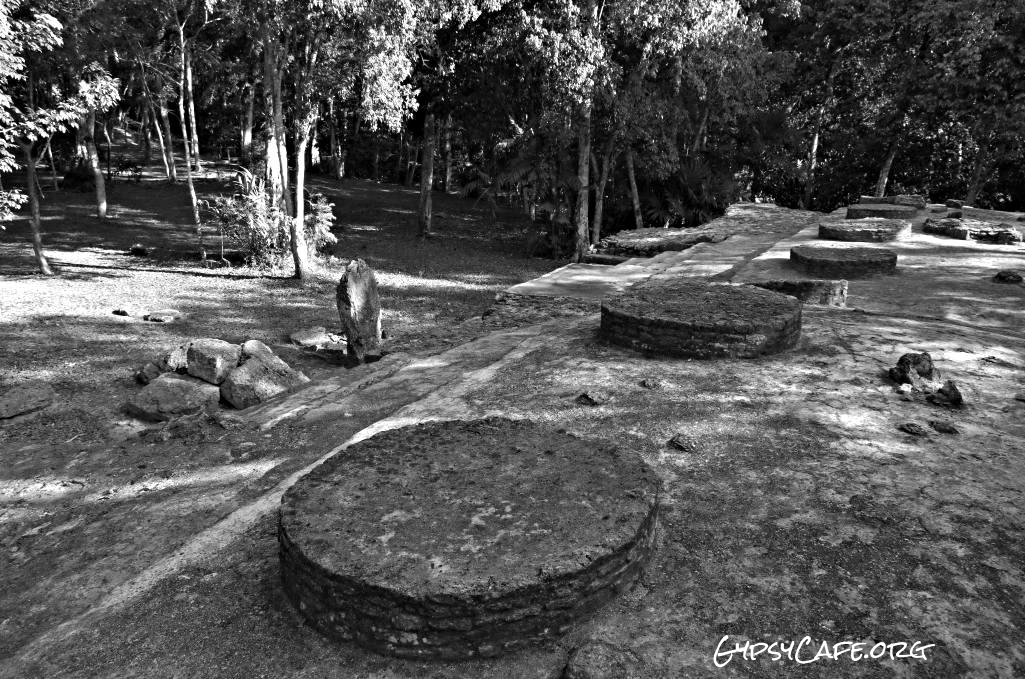
Humanity at the Crossroads (Part 2) – The Cyclic Reordering of Civilizations
**
These essays are written for individuals who have a spiritual interest in Navigating the Greatest Shift. They contain futurology based on cycle science and the mystical sciences. Readers are encouraged to read with critical minds and come to their own conclusions.
**
Introduction
How crises are responded to can make outcomes either better, or worse. Identifying the metaphysical story outlines of our times could assist in choosing the Right Road going forward. While some people might be happy with the roads they are on, others might find themselves on the wrong roads, contemplating a change of direction.
In the previous chapter, it was explained that the story outlines of each segment of a cycle are largely predetermined energetically, but that humans can positively (or negatively) act out their parts within the stories of the ages. This chapter, therefore, analyzes human behavior critically with regards to how humans acted out their parts during previous iterations of the time period that we will be entering soon.
Current events during 2022, seem to be developing in line with the energy of the current Katun, which is a Katun 2-Ahau from 2012 to 2032 (see; Darkness Before Dawn – Part 1A & Part 1B). This essay, however, is primarily dedicated to the years 2032 to 2052, which will be a Katun 13-Ahau. The following discussion concerns the possibility of history rhyming post-2032.
Alchemy Provides Insights
For with wisdom did someone once reveal the maxim, now famous, that evil at one time or another seems good, to him whose mind a god leads to ruin – Sophocles (Antigone) [1]
When the metaphysical energy of a very large cycle turns downwards towards the end of it, the human collective’s consciousness turns downwards too (see; The Lights Along the Way). From the perspective of alchemy, human consciousness darkens. The result is that the collective mind descends into the depths of materialism where dark passions rule and sacred laws are forgotten. How crises are then interpreted, understood and responded to could result in more destruction, not less.
Progressing into Collapse
Civilizations die from suicide, not by murder – Arnold Toynbee (A Study of History) [2]
It’s a fact of history that some empires and civilizations have progressed themselves into collapse, as important historians have pointed out. Any large empire’s drive to always expand and conquer would eventually be confronted with limits to expansion. A phase of stagnation would occur, followed by a contraction. The decline of the Roman Empire would be the most classic and cited example.
Ultimately, there are only so many places that can be conquered, co-opted, subjugated, invaded, or plundered by an empire within its life cycle – but it’s only through unending expansion that empires can maintain the costs of running such large operations. The expansionist objectives and drives of empires would usually also be confronted by rival powers that would limit their further expansion.
When there’s less external wealth flowing in from all the colonies and satellites, the wealth extraction processes would inevitably ‘come home’, usually by means of higher and more taxes and by way of currency debasements. Various subtle – and not so subtle – forms of wealth expropriation would follow, leading to a general decline in prosperity for the population at large.
Declining empires would tend to increasingly hide their problems as things continue to degrade, while in general, the citizens would be happy to occupy themselves with a variety of distractions. The most famous example would be the bread and circuses of the declining Roman Empire. The present-day equivalent of that would be the plethora of digital distractions that are so popular with everyone.
A Time of Inner Decline
When human beings cease to be controlled by deeply interiorized religious, ethical, aesthetic and other values, individuals and groups become the victims of crude power and fraud as the supreme controlling forces of their behavior, relationship, and destiny – Pitirim Sorokin (The Basic Trends of Our Times) [3].
A feature of failing civilizations is that wide-scale corruption and a loss of ethics and morality would occur alongside the degradation of everything else. That would happen not only on the part of the citizens but also on the part of political leaders. Important historians in the West, who have explored this particular feature of civilizations in decline, were Arnold J. Toynbee (University of London) and Pitirim Sorokin (American Sociological Association).
Scheduled for Collapse
The phenomenon of civilizations progressing themselves into collapse also happened to some of the great ancient civilizations of the past, including the Classic Maya civilization and the civilization of Easter Island. A lot of mystery still surrounds the real circumstances under which both of them declined, but a variety of factors – including environmental and climate issues, as well as depleting resources – are usually listed.
This essay will argue that the decline of many civilizations – old and new – has more to do with a shift in the spirit of the age than with other factors, even though other factors also naturally play a part. In the spirit of Cycle Science (which is what most of these essays are about), it is, therefore, worth taking a closer look at ‘collapse’ from a metaphysical, energy perspective. The result, as the reader will see, points to a pattern of cyclic collapse.
The Mystery of Easter Island
When looking at the facts surrounding the collapse of Easter Island, it would appear that something must have ‘come over’ the island’s inhabitants that caused them to destroy their own civilization. It is well known that at some stage the Rapanui people started to topple the statues on the island named Moai in the Rapanui language.
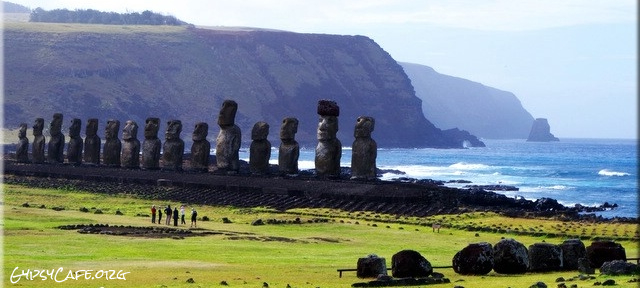
Moai were commissioned by the tribes from the island’s quarry and transported with great effort (considering their weights and sizes), to the various tribal locations. Once positioned on its platform, a Moai was meant to provide spiritual protection for a tribe. Each Moai was believed to embody – or contain – the spirit of a passed headman or ancestor, as the Rapanui had a system of ancestor worship [4].
The islanders must have had very strong convictions about the existence of the supernatural, to have maintained their beliefs so long, considering the lengths they had to go to, in order to practice them. It would, therefore, seem plausible that a shift must have occurred in the mindsets of the people.
Easter Island’s tribes toppled each other’s statues during internecine warfare – the Moai did not fall over due to bad weather conditions [5]. It’s a curious matter though, because one would have thought that after the warfare had subsided, the islanders would have been motivated to restore their Moai (considering their strong spiritual beliefs), but that apparently didn’t happen. Records show that the toppled statues were left lying on the ground for more than 200 years until archaeologists started to put them upright again in 1955 [5].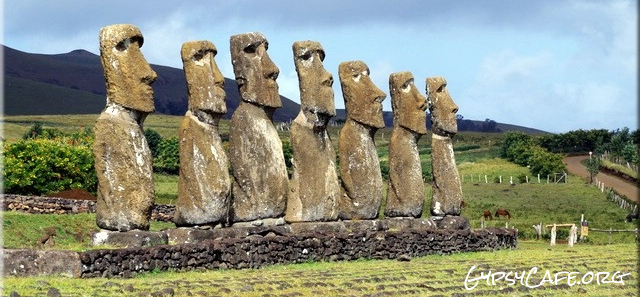
Anthropologists would know that belief systems such as ancestor worship do not just disappear overnight. It is all very strange, but if such a strong change could come over a people due to a possible shift in the spirit of the age – as hypothesized – it’s worth exploring the possibility further. Reasoning suggests that if something like that happened before, who’s to say it won’t happen again, there or elsewhere.
The ideal framework for such an exploration would be the Short Count Calendar of the Mayas, which is their 256-year Katun Cycle [6]. In previous essays, that cycle was used to illustrate how cyclic changes in mindsets and human behavior can occur in the real world (see; Exploring Paradigm Shift Time Frames and Maya Katun Prophecy is Unfolding in Real-Time).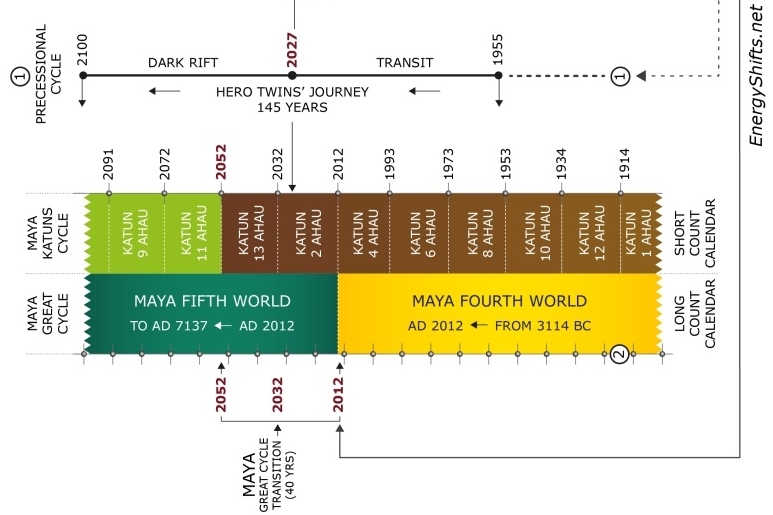
The Troubles on Easter Island
When evaluating the length of time that it took for mindsets to change on Easter Island, one can conclude – as will be illustrated – that they shifted relatively fast, within a window of 3 to 4 years. The behavior of the people on the island went literally from constructive through their practice of raising statues for spiritual protection, to destructive by demolishing those very same statues.
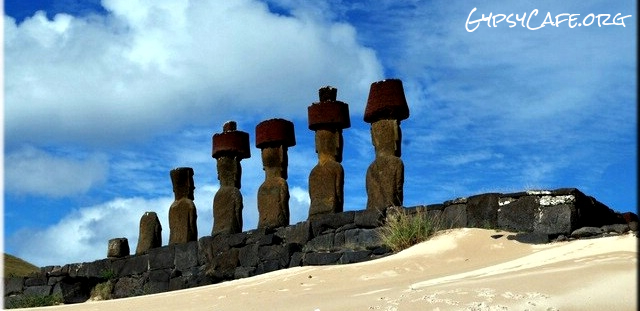
Counting back in time by 256 years – which is one Katun Cycle – from the year 2032, brings us to the year 1776. The explorer Captain James Cook visited Easter Island two years earlier in 1774 [5] and noticed that some of the statues on the island were toppled but others were still standing.
Four years earlier, in 1770, another visitor who was a Spanish captain from Peru [7] did not notice any toppled statues. From those eyewitness accounts, one can ascertain that the Rapanui started to topple the Moai about 3 to 4 years prior to 1776. The year 1776 was the start of a Katun 13-Ahau [6] which was the final 19.7-year segment in the previous Katun Cycle. In the current Katun Cycle, the Katun 13-Ahau will start in 2032 [6].
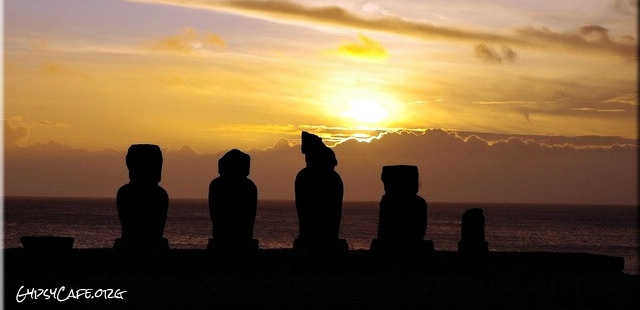
Records show that the toppling of statues on Easter Island continued for around 66 years between around 1772 until 1838 [5]. Easter Island eventually recovered, but it was never the same again. Its inhabitants were dramatically affected by the long-term turmoil and further events on the island played a major part in altering the population. Although a small island, Easter Island’s trajectory of decline was similar to those of larger civilizations.
Larger Cycles at Work
In the previous chapter, it was explained that Maya Katun ages have a similar energy configuration whenever they come around and that could result in a similar story outline every time. There are, however, larger cycles at work too which would not be the same as before (see; The Lights Along the Way). As the saying goes;
History Does Not Repeat Itself, But it Rhymes [8]
The Troubles of the Roman Empire
In order to determine the existence of a relatively clear pattern of cyclic collapse, other historical examples would have to be considered too – and that brings us to the troubles of the Roman Empire.
Counting back seven full Katun Cycles from the year 2032 takes us to the year AD 238. That year was also the start of a Katun 13-Ahau. AD 238 came to be known as The Year of the Six Emperors [9] and – as the name implies – six emperors ruled within just 12 months. Some of them were assassinated, others died in clashes with invaders and others were deposed.
The Year of the Six Emperors came three years after the Crisis of the Third Century began [10] which lasted for around 50 years from AD 235 to AD 284. During that time, as many as 26 different emperors ruled for relatively short periods. Just as with Easter Island, Rome’s troubles started about 3 or 4 years prior to the start of the Katun 13-Ahau.
The Crisis of the Third Century caused the Roman Empire to fracture, leading to its near-collapse. It split into three [10] during its crisis but ended up being composed of two parts [11]. The Western part of the Roman Empire continued to decline and fracture further into separate city-states and kingdoms [11], but the Eastern part grew in strength and ruled for at least another 1,000 years [12].
Rome’s architecture, religion, literature and art all went through major changes during its Crisis of the Third Century and historians view that period as the transition from classical antiquity to late antiquity [13]. An important and notable feature of the crisis periods examined in this essay is that they resulted in significant shifts in mindsets and, therefore, also noticeable cultural shifts.
With that in mind, one could speculate that the reason why the Easter Islanders did not restore their toppled statues after their wars, was because the island as a whole had undergone a significant cultural shift during its troubles.
The Troubles in Other Locations
The United States Declaration of independence was signed in 1776 [14] at the start of the same Katun 13-Ahau as Easter Island’s troubles. Developments during the decade leading up to 1776 resulted in the 8-year American Revolutionary War that started in 1775 and ended in 1783 [15]. The revolution set in motion a myriad of social changes [16] that unfolded in the post-revolution years and there was a general movement towards more freedoms and independence.
During that very same Katun 13-Ahau, the French Revolution [17] started in 1789 (13 years into the Katun). The Reign of Terror [18] was initialized in September 1793 and it lasted for about 10 months, ending in September 1794 a year before the end of that Katun. The French Revolution, including the Reign of Terror, lasted for a total of 10 years and France was irrevocably changed after that – culturally too and Romanticism bloomed after the French Revolution.
Counting back in time from 1776 by exactly one Katun Cycle brings us to the year 1520, which was the start of another Katun 13-Ahau. The following year, in 1521, the Aztec Empire fell [19] after a siege that lasted two months. The overthrow of the Aztec Empire by the Spanish Herman Cortez lasted for 2 years from 1519 to 1521 [20]. That event was a catalyst and the Yucatan was never the same again.
By now it should be relatively clear to the reader that upheaval is a major feature of every Katun 13-Ahau – and so is cultural change. From the examples cited so far, the observation is that the duration of the tribulation periods varied from a couple of years up to 50 or 60 years. However, it’s always worth keeping in mind – for maintaining a balanced view – that some parts of the world would have been relatively calm and tranquil in comparison.
A Time of Inner-Instability
A discussion on the French Revolution should be apt at this point, considering its parallels with Easter Island and the Roman Empire which will be highlighted in the next segments.
It was normal, everyday people, killing masses of other normal, everyday people. It was a civil war, not a class war [21].
One might wonder what on earth happened to France that caused its people to descend into such madness during the French Revolution. Madness certainly ruled the day during the Reign of Terror [18][21]. Not only did it feature indiscriminate massacres, murders, executions, reprisals and counter reprisals; but strange religious cults formed, such as the Cult of Reason [22], which was a state-sponsored atheistic religion, and the Cult of the Supreme Being [23], which was meant to counter the Cult of Reason (neither of them lasted very long).
The French Revolution is generally presented as an overall positive event, notwithstanding the murder and mayhem that took place during the Reign of Terror. The worst details of that stage of the revolution are usually downplayed – or brushed over – while the positive, post-revolution outcomes are lauded with regards to it leading to more individual rights and freedoms, i.e. the rights of man [23].
However, there’s no reason to believe that it would not have been possible to achieve more individual rights and freedoms without descending into such uninhibited self-destructive madness and bloodshed. Indeed, after all was said and done, (after the revolution) France still ended up with a monarch, albeit a somewhat better one, but hierarchy returned – as it always does. Hierarchy still exists in France today.
It was the American Revolution that first inspired the French Revolution [24] and in turn, the French Revolution inspired others, like the Russian Revolution [25] which ended up leading to even more bloodshed than the French Revolution. What was supposed to be a ‘normal revolution’ in France (on the inspiration of the American Revolution), descended into the Reign of Terror, so something went wrong.
Cyclic Darkness Affects Humanity
This writer’s reading of events is that what happened during the tribulations of France during its Reign of Terror, during the Roman Empire’s Crisis of the Third Century and during Easter Island’s civil war and statue-toppling, were examples of cyclic darkness affecting the psychologies of people – and that caused things to spiral out of control. The populations in those nations went to war with themselves because civil wars are internal wars.
Non-Structure is Always Temporary
With transitions from the perspective of anthropology [26][27][28][29], we come to understand that all transitions feature forms of non-structure and anti-structure, but structure would always return.
In short, the existence of structures and hierarchies are the norm [30], while life-stage transitions, wars and revolutions are all different types of liminal periods (described in the previous chapter), meaning that they are always transitive states. Relatively speaking, they are of short duration. The countries mentioned in this essay enjoyed long periods of stability before their periods of crises started.
It’s worth noting that revolutionaries typically tend to imagine or believe that hierarchies could be done away with forever. When hierarchy and structure fall away, it’s clearly (meant to be) temporary – but it’s those temporary states of non-structure that revolutionaries crave, which is why they would often attempt to prolong and extend the conditions of chaos and anarchy, because – simply put – they thrive in them [31].
The Romantic Lure of Destructive Processes
The most disconcerting aspect of the French Revolution (and others) is that many people today continue to view them through mostly romantic lenses. That points to the fact that there resides a latent unconscious destructive drive within people.
The implication is that excessive madness and bloodshed could be a result of any future revolution; the French and Russian revolutions speak for themselves after all. In both cases, opportunists [32] entered the revolutions and steered them into uncontrollably destructive directions – and, it must be added – with a lot of support from the common people at the time.
It would seem that humans have not yet managed to devise ways of arriving at more freedoms and rights for themselves without having to revert to revolutions. That’s probably because no solution has yet been found to reduce, limit, or stop dark archetypes from rising up into positions of power and corrupting everything.
Although revolutions end up being perceived as the only possible solution, the irony is that revolutions themselves are usually taken over by dark archetypes [32]. In a nutshell, the moral of the story is that there is no way to know whether humanity would be able to escape falling into deeper levels of darkness in some parts of the world post-2032.
The Troubles of the Classic Maya Empire
This brings us to the Classic Maya Civilization which declined during a Katun 1-Ahau, not during a Katun 13-Ahau. Their time of upheaval happened during a different stage of a Katun Cycle (in the center of it which would also be a strong shift point, rather than at the end), but their decline had a similar trajectory, although it was also different in some respects, which makes studying it valuable.
Katun 1-Ahau; This Katun brings even worse troubles, weak rulers and destruction. Governments fall apart due to rivalries. There may also be a great war which will end and brotherhood will return – Bruce Scofield (The Maya Katun Prophecies) [6]
Spiritual guide, Carlos Barrios, mentions in his book, The Book of Destiny [33], that the Classic Maya Empire was to an extent allowed to disintegrate consciously by consensus according to what the energies demanded of the people.
The reason was that the Mayas built their cities on intangible energy centers (spiritual energy points) and when the energy shifted they would relocate to new energy centers to create settlements there. Kenneth Johnson stated something similar in one of his books;
The Mayan world did not end when the cities of the Classic Period began to decline. It simply shifted gears; the locus of energy moved from the ancient capitals to new ones – Kenneth Johnston (The Mayan Prophecies: The Renewal of the World 2012 to 2072) [34]
These factors might shed some important light on the mystery of the ‘collapse’ of the Classic Maya because their empire declined over a long period of time [35]. The Mayas would likely have known that the cyclic reordering of their civilization was upon them, and they could, therefore, have oriented themselves accordingly.

That being the case, there were many conflicts and wars between rival Maya city-states and the decline of the Classic Maya also had to do with local resource depletion and forms of environmental degradation; so it was a variety of factors that played a role in the dispersion of people away from large populated centers.
Worn out with a deadly combination of constant internecine warfare and the over-farming of land with limited resources, the mighty centers which had once been powerful city-states began to be abandoned – Kenneth Johnston (The Mayan Prophecies: The Renewal of the World 2012 to 2072) [36].
By the time that new Maya capitals were established in new locations, a major cultural shift had taken place during the transition period. Changes had taken place in Mayas’ architectural styles, art styles and hieroglyphic writing; and there were significant modifications in their societal structures too [36].
The Cyclic Reordering of Civilizations
The cyclic reordering of civilizations would seem to consist of a general pattern. As an empire grows and expands, a gradual process of centralization would be a result, but an inevitable stagnation would eventually set in due to various limits to expansion. That’s followed by a time of troubles, after which a process of disintegration takes place; a subsequent dispersion of people would be the result and new settlements on a smaller scale would then form.
In many cases, warfare and conflicts would play a major role. The migration of people out of large centers would normally result in decentralization, but smaller scaled centralization would still occur in regional centers. A return to agricultural lifestyles out of necessity would usually be a trend and this is a verifiable pattern in history; the Roman and Classic Maya Empires were examples.
On that point, one could venture that trying to hold things together when they are clearly starting to fall apart would just prolong the inevitable and probably make things worse than they already are.
An Empire State of Mind
It would seem that what’s thought of as a ‘collapse’ in modern terms is not really a collapse, but rather a period of dramatic change. In practice, a ‘collapse’ basically comes down to a shift from centralization to decentralization. From a central-planning point of view, such a prospect would, however, be considered a looming calamity of epic proportions, so the word ‘collapse’ is invoked.
Empires would naturally try to preserve their centralized format because that’s the nature of an empire. Moreover, they would attempt to expand their operations when they are facing almost certain stagnation and contraction (which happened in the case of the Roman Empire). The prospect of losing centralized power – and income – would lead to a variety of strategies to attempt to restore growth and expand territories (or hold on to the ones already conquered).
Current Affairs
Decentralization from a personal, individual or small community perspective would under normal circumstances be viewed as something positive, but – as should be relatively obvious to anyone in touch with current affairs – the globe is moving towards more centralization through a variety of systems that have to do with forms of global technological industrialization (i.e. The Fourth Industrial Revolution). [37]
Uni-polarity, Bipolarity and Multi-polarity
The world seems to be moving geo-politically from uni-polarity, with the Western block being in charge of more or less the entire globe (through various multinational and transnational institutions and mechanisms) to bipolarity. The latter would seemingly entail the Eastern block and its affiliates ending up with as much power as the West, through the formation and creation of parallel structures and mechanisms [38].
That a new Cold War is on the cards should be relatively clear by now, considering the serious geopolitical events that have developed by the middle of 2022 (in July, at the time of writing). Notably, since Russia invaded the eastern parts of Ukraine in February, there seem to have been few noticeable de-escalation activities or processes, so a new Cold War might even be the objective.
Prior to all these dramatic recent developments, though, there was already a lot of talk about the world moving towards multi-polarity, but what would multi-polarity look like? True multi-polarity – the writer would venture – would constitute a decentralized post-empire scenario.
Presently, there are two very large power-blocks that are vying for global control with the smaller nations within their spheres of influence falling under their direction and control. In other words, what seems to be in the making at present would constitute a bipolar world with the protagonists being the Western World and its allies on the one side, and the BRICS nations and their affiliates [38] on the other side.
One could argue that if the institutions and structures of these two large power-blocks more or less exactly resemble each other, then the world would in effect still be in a uni-polar world, but only with two separate poles that function in a similar way. Such a state could be likened to the center of power shifting from the Western Roman Empire to the Eastern Roman Empire during its Crisis of the Third Century. Eventually, the Western pole continued to decline and crumble, while the Eastern pole continued to grow in strength.
To summarize; considering the slow historical trajectory highlighted before from centralization to decentralization with tumultuous in-between phases; official forms of autonomy and sovereignty for nations, states and cultures could eventually be the outcome, but how long that would take is unknown.
In the interim – it would seem – the general trajectory is still towards centralization, but in the context of bipolarity under the auspices of multi-polarity. Shifts are gradual, as Maya spiritual leader Carlos Barrios said in a message in 2020 [39].
Towards an Autonomous Road
Considering that most of the world’s governments are tied into global institutions due to numerous international treaties and commitments, the roads towards independent and localized solutions can really only be created by individuals, families and small communities through autonomous self-determined and self-guided decision-making and action-taking.
A road of individual independence, personal self-determination and local self-sufficiency would be an ideal – and it does sound very appealing – it must be stated, though, that making such a transition can in practice be easier said than done, especially in terms of having to shift one’s mindset away from an urban lifestyle (see also; Going Beyond Limits to Growth).
That said, what we know from the Roman Empire’s decline is that people eventually had very little choice – they had to get out of the cities to grow food for survival. However, it’s also true that people have different circumstances, contexts, situations and environments. How individuals will be dealing with the crises that the world will be facing would therefore differ. Hence, it would be unrealistic to imagine that there can ever be a one-size-fits-all solution.
Learning From History
The world is not in a state of collapse, but that a time of great change is upon the world is not in dispute. Perhaps we can take a feather out of the cap of the Classic Mayas in terms of a possible way forward. They had the courage to look at the patterns of history and plan accordingly. The decline of the Roman Empire could provide various lessons too, and it’s well-worth studying.
Directing one’s personal energy towards creating or joining islands of structure and stability in advance of the upcoming oceans of instability could be a wise preemptive move – where that might be possible. The ultimate islands of stability (the pillars of communities) are always the individual humans who are internally structured and truth-oriented, wherever they may be found.
There are no easy or clear answers when it comes to ways of dealing with growing conflict, for reasons already discussed. The inherent danger of large-scale conflicts is that they could spiral out of control and descend into wholesale and long-lasting destruction. A realist would have to admit, though, that in the real-world conflict is sometimes unavoidable and inevitable; as unfolding events in the world show us on a daily basis.
The Role of the Individual
Despotism, totalitarianism, dictatorships, repressive regimes, and the like; all are results of the darkness that resides within people in positions of power, as well as within the members of societies that would typically support them. It’s ultimately up to humans to evolve themselves beyond a state where they allow darkness to take over and control them, whether they are leaders or followers.
The reality is that metaphysical energy transitions that entail overall positive shifts in consciousness can take decades to complete in the larger cycles. In the interim – with respect to the smaller cycles – it takes personal commitment through willpower and dedicated spiritual work to align oneself with the positive aspects of a transition.
But, in reality, only a change in the attitude of the individual can bring about a renewal in the spirit of the nations. Everything begins with the individual – Carl Jung (Civilization in Transition) [40]
Conclusion
This chapter has illustrated how Cycle Science, coupled with a study of history and human behavior, can assist in seeing the broad story outlines of recurring stages in history. The advantage of having metaphysical frameworks of understanding is that they can aid in better personal decision-making going forward.
The following (previously published) chapters are recommend reading after this chapter:
Going Beyond Limits to Growth
The Maya World Tree
The Keys to Conscious Co-Creation
Text and photography by J.J. Montagnier
J.J. Montagnier is an independent researcher and writer. He visited Easter Island and Central America in 2015. The views and opinions are those of the writer. Creative license has been applied to make some concepts more accessible. References to and excerpts from this essay may be used with direction back to the original content on this page.
Copyright © · All Rights Reserved · GypsyCafe.org
References:
[1] Sophocles, Antigone, line 615. (n.d.). Perseus Digital Library. Retrieved July 15, 2022, from https://www.perseus.tufts.edu/hopper/text?doc=urn:cts:greekLit:tlg0011.tlg002.perseus-eng1:615-625
[2] Arnold J. Toynbee Quotes. (n.d.). BrainyQuote.com. Retrieved July 15, 2022, from BrainyQuote.com Web site: https://www.brainyquote.com/quotes/arnold_j_toynbee_165737
[3] Pitirim A. Sorokin. (n.d.). Great Thoughts Treasury. Retrieved July 15, 2022, from https://www.greatthoughtstreasury.com/authors/single/60a2a8757036d21c9f76b306/1
[4] Peterkin, J. G. (2010). A companion to Easter Island: A Concise Guide to the History, Culture and Individual Archaeological Sites of Rapa Nui (2nd ed.). Grafica LOM, Chile. p14.
[5] Peterkin, J. G. (2010). A companion to Easter Island: A Concise Guide to the History, Culture and Individual Archaeological Sites of Rapa Nui (2nd ed.). Grafica LOM, Chile. P18.
[6] One reed: The Maya Katun Prophecies. (n.d.). One Reed Publications. Retrieved July 15, 2022, from https://onereed.com/articles/katun.html
[7] Peterkin, J. G. (2010). A companion to Easter Island: A Concise Guide to the History, Culture and Individual Archaeological Sites of Rapa Nui (2nd ed.). Grafica LOM, Chile. p16.
[8] History Does Not Repeat Itself, But it Rhymes. (2014, January 12). Quote Investigator – Tracing Quotations. Retrieved July 15, 2022, from https://quoteinvestigator.com/2014/01/12/history-rhymes/
[9] The Year of the 6 Emperors. (n.d.). History Hit. Retrieved July 15, 2022, from https://www.historyhit.com/the-year-of-the-6-emperors
[10] Mark, J. J. (2017, November 09). The Crisis of the Third Century. World History Encyclopedia. Retrieved from https://www.worldhistory.org/Crisis_of_the_Third_Century/
[11] Frater, J. (2016, October 13). 10 Dying Symptoms of the Roman Empire. Listverse. Retrieved July 15, 2022, from https://listverse.com/2016/10/13/10-dying-symptoms-of-the-roman-empire/
[12] Byzantine Empire. (2018, September 19). World History Encyclopedia. Retrieved July 15, 2022, from https://www.worldhistory.org/Byzantine_Empire/
[13] Late Antiquity. (n.d.). Main Page – The Art and Popular Culture Encyclopedia. Retrieved July 15, 2022, from https://www.artandpopularculture.com/Late_Antiquity
[14] Declaration of Independence (United States). (n.d.). New World Encyclopedia. Retrieved July 15, 2022, from https://www.newworldencyclopedia.org/entry/Declaration_of_Independence_(United_States)
[15] American Revolution. (n.d.). New World Encyclopedia. Retrieved July 15, 2022, from https://www.newworldencyclopedia.org/entry/American_Revolution
[16] Societal Impacts of the American Revolution. (n.d.). US History. Retrieved July 15, 2022, from https://www.ushistory.org/US/12.asp
[17] The French Revolution. (2019, June 26). French Revolution. Retrieved July 15, 2022, from https://alphahistory.com/frenchrevolution/
[18] The Reign of Terror. (2020, September 30). French Revolution. Retrieved July 15, 2022, from https://alphahistory.com/frenchrevolution/reign-of-terror/
[19] Cortés & The Fall of The Aztec Empire. (2016, July 4). World History Encyclopedia. Retrieved July 15, 2022, from https://www.worldhistory.org/article/916/cortes–the-fall-of-the-aztec-empire/
[20] Learn, J. R. (2021, August 13). The Fall of the Aztec Empire: What Really Happened in the Battle of Tenochtitlan? Discover Magazine. Retrieved July 15, 2022, from https://stage.discovermagazine.com/planet-earth/the-fall-of-the-aztec-empire-what-really-happened-in-the-battle-of
[21] How the French Revolution Turned to Terror. (2007, March 4). ThoughtCo. Retrieved July 15, 2022, from https://www.thoughtco.com/french-revolution-the-terror-1793-94-1221883
[22] Cult of reason. (2020, June 17). The Spiritual Life. Retrieved July 15, 2022, from https://slife.org/cult-of-reason/
[23] Slife. (2020, June 17). Cult of the Supreme Being. The Spiritual Life. Retrieved July 15, 2022, from https://slife.org/cult-of-the-supreme-being/
[24] The American Revolution. (2020, October 6). French Revolution. Retrieved July 15, 2022, from https://alphahistory.com/frenchrevolution/american-revolution/
[25] Deutscher, I. (1952). The French Revolution and the Russian Revolution: Some Suggestive Analogies. World Politics, 4(3), 369-381. https://doi.org/10.2307/2009128
[26] Gennep, A. V. (1960). The Rites of Passage (1st ed.). University of Chicago Press.
[27] Turner, V. W. (1969). The Ritual Process: Structure and Anti-structure. Cornell University Press.
[28] Szakolczai, A. (2000). Reflexive Historical Sociology. Routledge.
[29] Thomassen, B. (2014). Liminality and the Modern: Living Through the In-between. Ashgate.
[30] Thomassen, B. (2014). Liminality and the Modern: Living Through the In-between. Ashgate, pp.207-212.
[31] Thomassen, B. (2014). Liminality and the Modern: Living Through the In-between. Ashgate, p.210.
[32] Thomassen, B. (2014). Liminality and the Modern: Living Through the In-between. Ashgate, p.207.
[33] Barrios, C. (2009). Book of Destiny: Unlocking the Secrets of the Ancient Mayans and the Prophecy of 2012. HarperOne.
[35] The collapse of Classic Maya Civilization. (n.d.). Encyclopedia Britannica. Retrieved July 15, 2022, from https://www.britannica.com/topic/pre-Columbian-civilizations/The-collapse-of-Classic-Maya-civilization
[36] Johnson, K., 2012. The Mayan Prophecies: The Renewal of the World 2012-2072. Taos, New Mexico: Mystical Jaguar Productions.
[37] What Is The Fourth Industrial Revolution: Risks, Benefits & Responses. (n.d.). Research. Retrieved July 15, 2022, from https://research.com/careers/what-is-the-fourth-industrial-revolution
[38] BRICS Summit Sees New Role for the Bloc in a Changing World. (2022, June 24). MercoPress. Retrieved July 15, 2022, from https://en.mercopress.com/2022/06/24/brics-summit-sees-new-role-for-the-bloc-in-a-changing-world
[39] Carlos Barrios. (n.d.). Rooted Messages: Raising Consciousness. Retrieved July 15, 2022, from https://rootedmessages.com/carlos-barrios/
[40] C. G. Jung. Civilization in Transition. Part 10 of The Collected Works. The Bollingen Series. Princeton University Press, 1964. CW10, Para 459.
—


13 Comments
What I highly interresting report on world history and the human being, Jean- Jacques!
I very much like the sentence by Karl Jung: Only a change in the attitude of the individual can bring about a renewal of the spirit of the nations.
Many thanks and all the best:)
Martina
I really appreciate you taking the time to read through it Martina! 🙂 It took a while to write and research, but it seemed the right thing to do, considering the times that we live in. That’s probably my favourite quote from Jung!
Thank you always for your dedicated support.
Jean-Jacques
Excellent job, of presenting the changes through the different cycles, or K’atun, Jean Jacques, through an extensive, but easy understandable analysis, through History from different places like Easter Island, Roman Empire, Maya civilization, and the French Revolution.
Best wishes to you, Jean-Jacques
I’m very glad to hear that it was easy enough to read and clear because it was somewhat of a challenge to incorporate so much information and at the same time avoid too complexity. It was the cyclic pattern I wanted to highlight of the Katun and seems to have succeeded. Your feedback is very valuable to me – thank you!
Best wishes, to you too Mr Anaya.
Interesting article 🙂
Thank you for reading Mr Rosa – I appreciate it! 🙂
Here is an interesting recent presentation of an engineer based in Finland,
he evaluates whether a Circular Economy might be possible
(as it is proposed as a new model for the future).
His closing remarks are very informative, but all of this presentation is worth watching:
https://www.youtube.com/watch?v=MBVmnKuBocc
Pingback: Crossroads Crises in Perspective (Part 2) – The Greatest Trek – Gypsy Café
Pingback: Truth and Energy at the Crossroads
Pingback: Crossroads Crises in Perspective (Part 1) - The Bottleneck Ahead | Gypsy Café
“Counting back seven full Katun Cycles from the year 2032 takes us to the year AD 238. That year was also the start of a Katun 13-Ahau. AD 238 came to be known as The Year of the Six Emperors [9] and – as the name implies – six emperors ruled within just 12 months. Some of them were assassinated, others died in clashes with invaders and others were deposed. The Year of the Six Emperors came three years after the Crisis of the Third Century began [10] which lasted for around 50 years from AD 235 to AD 284.”
I’m impressed and appreciative of all the research you gathered around this. These dates jumped out at me, after the unexpected arrival of the Saint Lawrence devotional card. I’d never heard of him before. Saint Lawrence, Dec 31, 225 – Death Aug 10, 258. It’s hard to comprehend the brutality of those days – as something that could ever happen in our reality.
I mentioned that it was a dark dream that drew me to ask you more questions – that ultimately led me to all of this. The dream was about evil so pervasive and darker than I could imagine – with evil carrying on around us and unthinkable darkness knocking at our doors.
My thoughts on katun 13 Sun/AHAU – perhaps an Ascension, along with a decent in the opposite polarity of total madness. The Bible says that at some point, God allows humans to be “given over” to their evil ways… in effect leading to their own demise. Expansion is certainly the theme today on a stellar scale.
You mention that some carried on relatively “normal existence” when they isolated themselves into what appears to be “intentional communities” of group survival.
WATCHFULNESS AND VIGILANCE is the answer for today. And, just keep walking the Road to destiny.
[Edit: comment shortened]
Thanks for sharing your comprehensive thoughts, Debra! I will respond to everything by email.
J.J.
Pingback: Beyond Apocalypse (Part 1) - Mimetic Rivalry in the Tower of Babel | Gypsy Café
Pingback: (1) Mimetic Rivalry in the Tower of Babel – Energy Shifts